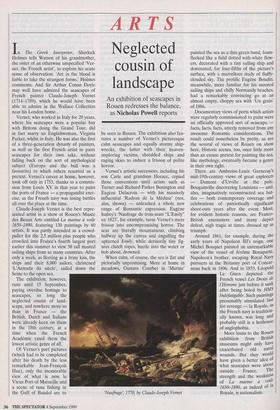ARTS
Neglected cousin of landscape
An exhibition of seascapes in Rouen redresses the balance, as Nicholas Powell reports n The Greek Interpreter, Sherlock Holmes tells Watson of his grandmother, the sister of an otherwise unspecified 'Ver- net, the French artist', to explain his acute sense of observation: 'Art in the blood is liable to take the strangest forms,' Holmes comments. And Sir Arthur Conan Doyle may well have admired the seascapes of French painter Claude-Joseph Vernet (1714-1789), which he would have been able to admire in the Wallace Collection near his London home.
Vernet, who worked in Italy for 20 years, where his seascapes were a popular buy with Britons doing the Grand Tour, did in fact marry an Englishwoman, Virginia Parker, whilst in Italy. He was also the first of a three-generation dynasty of painters, as well as the first French artist to paint seascapes for their own sake, without falling back on the sort of mythological subject (Europa and the bull was a favourite) to which others resorted as a pretext. Vernet's career at home, however, took off only in 1753, thanks to a commis- sion from Louis XV in that year to paint the ports of France — a propagandist exer- cise, as the French navy was losing battles all over the place at the time.
Claude-Joseph Vernet is the best repre- sented artist in a show at Rouen's Musee des Beaux Arts entitled La marine a voile 1650-1890, featuring 130 paintings by 60 artists. It was partly intended as a crowd- puller for the 2.5 million plus people who crowded into France's fourth largest port earlier this summer to view 38 tall masted sailing ships from as many countries. After only a week, as fleeting as a briny kiss, the ships and their 8,000 sailors, christened `L'Armada du siècle', sailed down the Seine to the open sea.
The exhibition, however, runs until 15 September, paying overdue homage to seascapes, so long the neglected cousin of land- scape, and nowhere more so than in France — the British, Dutch and Italians were already keen on them in the 18th century, at a time when the French Academic rated them the lowest artistic genre of all.
Of Vernet's port pictures (which had to be completed after his death by the less remarkable Jean-Francois Hue), only the memorable view of what is now le Vieux Port of Marseille and a scene of tuna fishing in the Gulf of Bandol are to be seen in Rouen. The exhibition also fea- tures a number of Vernet's picturesque calm seascapes and equally stormy ship- wrecks, the latter with their heaven- imploring victims, shredded ships and raging skies to induce a frisson of polite horror.
Vernet's artistic successors, including his son Carle and grandson Horace, copied those conventions until artists such as Turner and Richard Parkes Bonington and Eugene Delacroix — with his massively influential `Radeau de la Meduse' (not, alas, shown) — unleashed a whole new range of Romantic expression. Eugene Isabey's `Naufrage du trois-mats "L'Emily" en 1823', for example, turns Vernet's mere frisson into uncompromising horror. The seas are literally mountainous, climbing halfway up the canvas and engulfing the upturned Emily, while derisorily tiny fig- ures clutch ropes, hurtle into the water or bob about, drowned.
When calm, of course, the sea is flat and pictorially unpromising. More at home in meadows, Gustave Courbet in 'Marine' Waufrage', 1770, by Claude-Joseph Vernet painted the sea as a thin green band, foam- flecked like a field dotted with white flow- ers, decorated with a tiny sailing ship and dominated, for four-fifths of the picture's surface, with a marvellous study of fluffy- clouded sky. The prolific Eugene Boudin, meanwhile, more familiar for his moored sailing ships and chilly Normandy beaches, had a remarkably convincing go at an almost empty, choppy sea with lin grain' of 1886.
Documentary views of ports which artists were regularly commissioned to paint were an officially approved sort of seascape — facts, facts, facts, utterly removed from any awesome Romantic considerations. The result could nonetheless be pretty, as are the several of views of Rouen on show here. Historic scenes, too, once little more than an excuse pretext for painting the sea, like mythology, eventually became a genre in their own right.
There are Ambroise-Louis Garneray's mid-19th-century views of great explorers — Dumont d'Urville at the pole, Bougainville discovering Louisiana — and, also, imaginatively reconstructed sea bat- tles — both contemporary coverage and celebrations of patriotically significant shoot-outs years after the event. Most, for evident historic reasons, are Franco- British encounters and many depict defeat, nigh tragic at times, dressed up as triumph.
More loans to the Rouen exhibition from British museums might only have exacerbated old naval wounds. But they would have given a better idea of what seascapes were about outside France. The strength and the weakness of La marine a voile 1650-1890, as indeed of la Royale, is nationalism.


























































 Previous page
Previous page